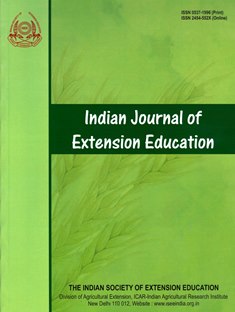Use of Generative AI by Small-scale Farmers in Nigeria: An Empirical Study
DOI:
https://doi.org/10.48165/IJEE.2025.61424Keywords:
Generative artificial intelligence, Small-scale farmers, Technology adoption, Digital divide, NigeriaAbstract
The study, conducted in 2025, investigated the digital readiness and use of generative artificial intelligence (AI) among small-scale farmers in Nigeria. A multi-stage sampling technique was used to select 120 small-scale farmers, and data were collected through interview schedules. The majority (62.5%) were small-scale farmers with over ten years of farming experience. Many of the small-scale farmers had digital access as a lot of them owned smart phones (64.2%) had internet connectivity (65%), and regularly used the internet (53.3%). Traditional media (Radio and TV) (63.3%) remained their primary source of agricultural information. Extension service access (4.2%) was notably low. Many small scale farmers (64.2%) had used generative AI, mainly for accessing information (45%) and conducting basic research about their farm operations and general well-being (17.5%), and most indicated willingness to continue its use (89.2%). However, major barriers to the use of generative AI included limited awareness and lack of access to digital devices. AI awareness was generally low but positively associated with education. Although generative AI adoption is growing, significant challenges remain, underscoring the need for targeted generative AI training in agriculture as well as the design and implementation of more generative AI awareness program.
Downloads
References
Adenubi, O., Temoso, O., & Abdulaleem, I. (2021). Has mobile phone technology aided the growth of agricultural productivity in sub Saharan Africa? South African Journal of Economic and Management Sciences, 24(1), a3744. https://doi.org/10.4102/sajems.v24i1.3744
Adesina, A. A. (2015). Bridging the digital divide: Technology adoption among rural farmers. International Journal of Agricultural Economics, 3(2), 89–95.
Aker, J. C., & Ksoll, C. (2012). Information and market efficiency: Evidence from a mobile phone intervention in Niger. American Economic Journal: Applied Economics, 4(4), 94–115.
Aker, J. C., & Mbiti, I. M. (2010). Mobile phones and economic development in Africa. Journal of Economic Perspectives, 24(3), 207–232. https://doi.org/10.1257/jep.24.3.207
Anand, S., Prakash, S., & Singh, A. K. (2022). Determinants of ICT tools accessibility by farmers in Bihar. Indian Journal of Extension Education, 58(3), 186–189. https://epubs.icar.org.in/index.php/IJEE/article/view/125201/47194
Bommasani, R., Hudson, D. A., Adeli, E., Altman, R., Arora, S., von Arx, S., & Liang, P. (2021). On the opportunities and risks of foundation models. Stanford University. https://arxiv.org/pdf/2108.07258
Chaturvedi, P., & Vatta, L. (2025). Exploring the strategies, utilisation and limitations of digital tool adoption in sugarcane farming. Indian Journal of Extension Education, 61(1), 118–122. https://epubs.icar.org.in/index.php/IJEE/article/view/161568/58929
Das, S., Argade, S. D., De, H. K., Kilodas, R., Sahoo, B., & Sreenivasan, P. (2024). ChatGPT as an AI-enabled academic assistant: Attitude and usage among fisheries students. Indian Journal of Extension Education, 60(3), 54–59. https://epubs.icar.org.in/index.php/IJEE/article/view/152495/55024
Doss, C. (2018). Women and agricultural productivity: Reframing the issues. Development Policy Review, 36(1), 35–50. https://doi.org/10.1111/dpr.1224
FAO. (2020). The state of food and agriculture 2020: Overcoming water challenges in agriculture. Rome: FAO. https://doi.org/10.4060/cb1447en
FAO. (2021). Digital agriculture report: Rural e-commerce development–experience from China. Food and Agriculture Organization of the United Nations. https://openknowledge.fao.org/server/api/core/bitstreams/ae214fb0-fe76-46a1-b4a1-83052956b8d4/content
Federal Ministry of Agriculture and Rural Development (FMARD). (2023). National agricultural extension policy 2020. Abuja, Nigeria. https://rescar.org/storage/dossier_file_etudePublication/nigeria-national-agricultural-extension-policy-1710259119.pdf
Goodfellow, I., Pouget-Abadie, J., Mirza, M., Xu, B., Warde-Farley, D., Ozair, S., Courville, A., & Bengio, Y. (2014). Generative adversarial nets. Advances in Neural Information Processing Systems, 27. https://papers.nips.cc/paper_files/paper/2014/hash/f033ed80deb0234979a61f95710dbe25-Abstract.html
High Level Panel of Experts (HLPE). (2013). Investing in smallholder agriculture for food security. HLPE Report 6. Committee on World Food Security. http://www.fao.org/3/i2953e/i2953e.pdf
Kolapo, M. F., & Didunyemi, B. O. (2024). Education as a driver of ICT adoption among smallholder farmers in Nigeria. African Journal of Agricultural Research, 19(1), 12–23.
Lwoga, E. T. (2010). Bridging the agricultural knowledge and information divide: The case of selected telecentres and rural radio in Tanzania. The Electronic Journal of Information Systems in Developing Countries, 43(1), 1–14.
Mittal, S., & Mehar, M. (2016). Socio-economic factors affecting adoption of modern information and communication technology by farmers in India: Analysis using multivariate probit model. The Journal of Agricultural Education and Extension, 22(2), 199–212.
Ogwuegbu, D. A., & Ajobiewe, D. N. (2025). Ethical implications of digital technologies on socioeconomically disadvantaged communities in Nigeria. FNAS Journal of Scientific Innovations, 6(2), 51–56. https://fnasjournals.com/index.php/FNAS-JSI/article/view/630/550
Omotayo, O. M. (2005). ICT and agricultural extension: Emerging issues in transferring agricultural technology in developing countries. In S. F. Adedoyin (Ed.), Agricultural extension in Nigeria (pp. 145–158). Agricultural Extension Society of Nigeria.
Sarfo, J. B., Aremora, S., Adebote, M. O., Balogun, K. M., & Fashina, A. T. (2025). Generative AI: A new frontier for agricultural extension service in Africa – Revolutionizing farmer information access. Computer Science & IT Research Journal, 6(2), 94–103. https://doi.org/10.51594/csitrj.v6i2.1870
Shahriar, S., Corradini, M. G., Sharif, S., Moussa, M., & Dara, R. (2025). The role of generative artificial intelligence in digital agri-food. Journal of Agriculture and Food Research, 20, 101787. https://doi.org/10.1016/j.jafr.2025.101787
Vaswani, A., Shazeer, N., Parmar, N., Uszkoreit, J., Jones, L., Gomez, A. N., & Polosukhin, I. (2017). Attention is all you need. Advances in Neural Information Processing Systems, 30. https://papers.nips.cc/paper_files/paper/2017/hash/3f5ee243547dee91fbd053c1c4a845aa-Abstract.html
World Bank. (2019). Harvesting prosperity: Technology and productivity growth in agriculture. Washington, DC: World Bank. https://doi.org/10.1596/978-1-4648-1393-1
Downloads
Published
Issue
Section
License

This work is licensed under a Creative Commons Attribution-NonCommercial-NoDerivatives 4.0 International License.

